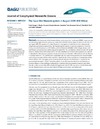Identificador persistente para citar o vincular este elemento:
https://accedacris.ulpgc.es/jspui/handle/10553/51627
| Título: | The Cape Ghir filament system in August 2009 (NW Africa) | Autores/as: | Sangrá Inciarte, Pablo Troupin, Charles Barreiro-González, Beatriz Desmond Barton, Eric Orbi, Abdellatif Arístegui, Javier |
Clasificación UNESCO: | 251001 Oceanografía biológica | Palabras clave: | Cape Ghir Cold filament Cool filament Intrathermocline eddy Submesoscale |
Fecha de publicación: | 2015 | Editor/a: | 2169-9275 | Publicación seriada: | Journal of geophysical research. Oceans | Resumen: | In the framework of the Canaries‐Iberian marine ecosystem Exchanges (CAIBEX) experiment, an interdisciplinary high‐resolution survey was conducted in the NW African region of Cape Ghir (30°38′N) during August 2009. The anatomy of a major filament is investigated on scales down to the submesoscale using in situ and remotely sensed data. The filament may be viewed as a system composed of three intimately connected structures: a small, shallow, and cold filament embedded within a larger, deeper, and cool filament and an intrathermocline anticyclonic eddy (ITE). The cold filament, which stretches 110 km offshore, is a shallow feature 60 m deep and 25 km wide, identified by minimal surface temperatures and rich in chlorophyll a. This structure comprises two asymmetrical submesoscale (∼18 km) fronts with jets flowing in opposite directions. The cold filament is embedded near the equatorward boundary of a much broader region of approximately 120 km width and 150 m depth that forms the cool filament and stretches at least 200 km offshore. This cool region, partly resulting from the influence of cold filament, is limited by two asymmetrical mesoscale (∼50 km) frontal boundaries. At the ITE, located north of the cold filament, we observe evidence of downwelling as indicated by a relatively high concentration of particles extending from the surface to more than 200 m depth. We hypothesize that this ITE may act as a sink of carbon and thus the filament system may serve dual roles of offshore carbon export and carbon sink. | URI: | https://accedacris.ulpgc.es/handle/10553/51627 | ISSN: | 2169-9275 | DOI: | 10.1002/2014JC010514 | Fuente: | Journal of Geophysical Research C: Oceans [ISSN 2169-9275], v. 120, p. 4516-4533 |
| Colección: | Artículos |
Citas SCOPUSTM
13
actualizado el 08-jun-2025
Citas de WEB OF SCIENCETM
Citations
14
actualizado el 08-jun-2025
Visitas
102
actualizado el 16-nov-2024
Descargas
170
actualizado el 16-nov-2024
Google ScholarTM
Verifica
Altmetric
Comparte
Exporta metadatos
Los elementos en ULPGC accedaCRIS están protegidos por derechos de autor con todos los derechos reservados, a menos que se indique lo contrario.
